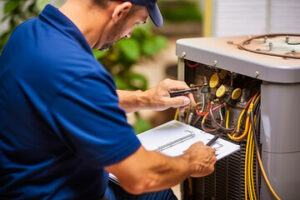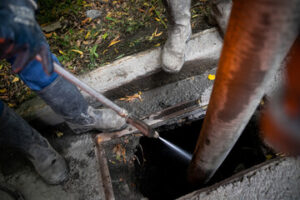During an air conditioning maintenance visit, your service technician will inspect equipment and clean system components. In many cases, he or she will also be able to make minor repairs as part of your service call.

However, some AC repair tasks like replacing motors or sealing refrigerant leaks require years of training and specialized tools. Contact Air Conditioning Repair Loveland OH for professional help.
The evaporator coil absorbs heat from your living spaces and transfers it to the air that circulates through your home. This is a critical function, but the slightest dust or debris on your evaporator coil can interfere with this process. As a result, the AC will run for longer cycles before it produces the desired level of cooling. This can wear out the system and lead to a host of problems.
If the evaporator coil is dirty, it can also prevent the AC from dehumidifying the home. The dirt acts as an insulator, preventing heat transfer to the air. Eventually, the coil can freeze over, which prevents the AC from cooling and causes it to turn off entirely.
Dirty evaporator coils can also result in unpleasant odors in the home. This is because odor-producing chemicals from cleaning products, paints and furnishings can accumulate on the coil and be blown into the living spaces during operation. This can aggravate allergies and respiratory issues for those in the home.
Keeping the coil clean can prevent these and other problems from occurring. You can do a simple DIY cleaning job by turning off power to the unit, removing the plenum and coil compartment doors and spraying the coil inside and out with a self-rinsing foaming coil cleaner. Be sure to close the doors before re-installing them. You should also minimize dirt and debris accumulation near the unit by cleaning the area around it, removing leaves and debris and trimming shrubs and trees.
You should also avoid contaminating the coil with water. You can do this by ensuring that the drain channels are clear and free of blockages. These channels help the coil to drain excess moisture that can discolor walls and carpets. You should also comb the aluminum fins on the evaporator coil with a tool called a fin comb to ensure they are not bent, which can interfere with the air flow and reduce efficiency.
If you are not comfortable performing a DIY coil cleaning, you can ask a professional to perform it. They can access the evaporator coil by turning off power to the unit, locating it and then removing the foil-wrapped insulation that covers it.
Dirty Compressor Coils
Dirty compressor coils can cause a wide range of problems. The most common is ineffective cooling, as dirty coils prevent your system from absorbing and dumping heat as it should. This causes your AC to run longer and harder to get the job done, which can eventually lead to damage to the unit or air quality issues.
The good news is that you can often prevent this problem by cleaning your condenser coil on a regular basis. Just make sure that the power supply to your outdoor unit is turned off before you start. Use a soft-bristle brush or a special coil cleaner to remove dirt and debris from the coil fins. Be sure to follow the manufacturer’s instructions regarding application and contact time. Finally, clear away any plants, bushes or other items that may be located near the unit and blocking the airflow.
Another sign of a dirty coil is an unexplained increase in your electricity bill. Your air conditioner will need to run longer to meet your cooling needs when the coils are clogged, which will cause your energy bill to spike. Additionally, dirty AC coils can impact your home’s energy efficiency rating, which could ultimately affect your ability to sell your house in the future.
Both evaporator and compressor coils can be cleaned on your own, but it’s important to have a professional perform regular maintenance services as well. An experienced technician can perform a comprehensive inspection of your unit and clean the coils thoroughly to prevent any serious issues down the road. They’ll also ensure that the airflow is free from obstruction and that there are no signs of a blockage in the refrigerant line. In addition, a professional will be able to spot any other potential issues and fix them before they have a chance to cause additional damage. For the best results, schedule regular maintenance services with a qualified service technician today. They’ll have the tools and expertise to clean both evaporator and compressor coils quickly, safely and effectively. They can also perform a thorough inspection of the unit to identify any potential problems and recommend repairs if necessary.
Low Coolant Levels
If your air conditioning system is not cooling the way it should, you may have low refrigerant levels. The system operates by circulating this pressurized refrigerant, commonly known as Freon, throughout the system to facilitate heat exchange. Leaks and other problems can cause the amount of refrigerant to decrease. Low refrigerant causes the system to work harder, which can damage the system and cause a costly breakdown.
The cooling system on your car has a sensor that monitors the coolant level and sends a signal to the engine computer or Body Control Module (BCM) when the coolant level is low. If the coolant level drops significantly, your vehicle will warn you with a warning light on the instrument panel and possibly illuminate the engine temperature gauge as well.
Over time, the cooling system can develop leaks in the radiator or the engine block that reduce the coolant level. Additionally, the coolant can evaporate into the engine oil or exhaust, causing overheating. If your vehicle overheats repeatedly, it can permanently damage the engine and require expensive repairs.
During an AC refrigerant recharge, technicians inspect the entire system for signs of a leak. If a leak is found, the technician will isolate and repair the leak. Once the system has been repaired, it will be recharged with new refrigerant.
In addition to hissing or bubbling noises, another sign of low refrigerant is ice on the compressor coil or evaporator coil. It also takes longer to cool a home when the refrigerant is low, which means higher energy bills.
The first thing you should do if you suspect you are low on coolant is to purchase a bottle of automotive coolant from your local hardware store. However, this will only temporarily fix the problem, since more coolant will eventually leak out of the damaged leak. To properly fix the issue, your technician will isolate and repair the leak and then refill the system with a new coolant that is free of contaminants that can damage the system in the future. The technician will then perform pressure tests and a vapor lock test to ensure the new coolant is safe for the system.
Damaged Coolant Lines
When coolant leaks, it takes away the chemical refrigerant that the compressor needs to cool the air. This isn’t just a major inconvenience, but it can also cause the compressor to overwork itself and ultimately burn out. Depending on the severity of the coolant leak, it may not be possible to fix the problem without replacing the compressor.
A visible coolant leak is the most obvious sign that your air conditioner is in need of repair. Look for a puddle under the AC unit, and note any rust or corrosion around the hose or hose clamps. If you see this, it’s important to call for professional help as soon as possible. Coolant is toxic and can cause severe physical sickness, so it’s best not to handle it on your own.
Another potential cooling problem is when the evaporator coils become too cold, which can prevent the AC system from working correctly. This is typically caused by low refrigerant levels, but it can be a result of a dirty condenser or other issues that require expert service.
The coolant lines in your air conditioner are responsible for bringing coolant from the radiator to the compressor, where it is used to create conditioned air. They are usually insulated to protect the coolant from extreme temperatures, but this insulation can wear out over time. If the insulation becomes damaged or worn out, it can allow hot air to enter the system and overheat the compressor.
A leaking coolant line can also be caused by a loose or broken hose clamp or a crack in the hose itself. This is usually a clear sign that the hose has internal damage and requires replacement. A collapsed hose is another common sign of failure, which is often caused by high heat or pressure, as well as a vacuum inside the engine’s cooling system. This is when the hose reinforcement fails and can no longer maintain its shape, which restricts coolant flow and leads to overheating.



